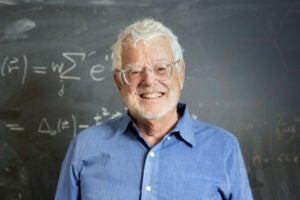Researchers, scholars and experts from The University of Texas at Austin are sought by news outlets every week for their knowledge, expertise and insights. Here’s a selection of recent media hits.
Frequent Tests Can Enhance College Learning, Study Finds
New York Times

James Pennebaker and Samuel Gosling, Department of Psychology, College of Liberal Arts
UT scientists James Pennebaker and Samuel Gosling in a recent report state that grading college students on daily quizzes actually improves both attendance and performance. The findings were a result of an experiment from UT Austin’s introduction to psychology class in which 901 students participated. Pennebaker and Gosling also found that computers can act as an aid to teaching, not just a distraction.
The report also found students from lower-income households performed particularly well. Read more about the findings.
Related Content:
Daily Online Testing Boosts College Performance and Reduces Achievement Gaps, Study Shows (UT News)
More Clues to Life in the Oceans on an Alien Moon, That Is
TIME.com

Krista Soderlund, Institute for Geophysics, Jackson School of Geosciences
In a new study, University of Texas at Austin geophysicist Krista Soderlund and several colleagues are using more sophisticated global ocean-circulation models, originally designed to study Earth’s seas, to shed light on the biological possibilities on Europa. The existence of water, in its liquid state, makes Jupiter’s moon Europa “perhaps the most fascinating of all the potentially life-bearing worlds.”
Is a future life-hunting mission possible? Find out.
Related Content:
Model Suggests Ocean Currents Shape Europa’s Icy Shell in Ways Critical for Potential Habitats (UT News)
The stealthy seahorse: Weird-shaped head makes it an awesome predator
Los Angeles Times
Brad Gemmell and Ed Buskey, Marine Science Institute, College of Natural Sciences
Seahorses are slow, docile creatures, but their heads are perfectly shaped to sneak up and quickly snatch prey, according to marine scientists Brad Gemmell and Ed Buskey from The University of Texas at Austin.
“A seahorse is one the slowest swimming fish that we know of, but it’s able to capture prey that swim at incredible speeds for their size,” said Gemmell, research associate at the University of Texas Marine Science Institute, which is part of the College of Natural Sciences.
Read more about the seahorse and its “no wake zone” for catching prey.
Related Content:
Small But Mighty: UT Researchers Discover Seahorse’s Secret Weapon (Alcalde)
Seahorse Heads Have a “No Wake Zone” That’s Made for Catching Prey (Texas Science)
New ‘invisibility cloak’ type designed
BBC
Andrea Alù, Department of Electrical and Computer Engineering, Cockrell School of Engineering

Could invisibility be a reality? UT researcher Andrea Alù is working on a not so far-fetched invisibility cloak now with the help of an active cloak which relies on electrical power to make objects “disappear.”
With active-cloaking technology, the cloaks can be thinner, therefore less conspicuous. This ultrathin cloak will be able to “hide” objects from detection at a broader frequency than current passive cloaks.
Read more about the Harry Potter-like possibilities from the BBC.
Related Content:
Researchers Design First Battery-Powered Invisibility Cloak (UT News)
People of the Book: ‘Thomas Jefferson’s Qur’an’
New York Times
Denise Spellberg, Department of History, College of Liberal Arts

In The New York Times’ Sunday Book Review, Kirk Davis Swinehart takes a look at Denise Spellberg’s new book “Thomas Jefferson’s Qur’an.” Spellberg traces the origins of Jefferson’s religious tolerance to his time at the College of William and Mary, where he studied law. Spellberg writes that Jefferson’s academic interest in Islamic law and religion yielded a fascination with Islamic culture that shaped his views of Muslims and his vision of American citizenship.
Swinehart writes, “‘Thomas Jefferson’s Qur’an’ breaks fresh ground and should, with any luck, inspire further elaboration.” Read his complete review.
Related Content:
Thomas Jefferson’s Qur’an (15 Minute History)



